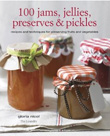SPILT MILK AND MOTHBALLS
Wednesday July 30th 2008, 4:31 pm

We’ve had a few days of really hot weather and I never think to change the temperature of the fridge to compensate for the extra heat. Subsequently some milk started to go off. It was only a bit off, off enough so it tasted strange in tea. In an attempt to be resourceful and thrifty (not a quality that comes naturally to me) I set about turning it into something else. However I didn’t really think it through. I could have made some scones or added the milk to the mixture when making a chocolate cake but I messed up big time and ended up with a house that smelt disgusting and a dish of tasteless rubbery cheese that would have needed other things added to it to make it even vaguely palatable. I had wasted a good hour of my time and the ‘cheese’ went in the bin.
Perhaps it is just me, but the whole idea of making use of leftovers makes life feel grim and miserable. Just the word ‘leftovers’ is depressing. As the need to be more mindful of waste becomes increasingly necessary, someone needs to rework the subject to make it appealing. We need a new vocabulary that makes food scraps and stale stuff exciting.
While I was scrabbling around trying to find a use for my sour milk I found an old household encyclopaedia that I had collected primarily for its colourful dust jacket. Set out in an A to Z format, for sour milk it says:
SOUR MILK This is very good for polishing linoleum. It will remove iron rust from white fabrics.
So next time perhaps I’ll give that a go, not that I have any linoleum in the house. I spent quite some time reading through the book though, which is filled with useful nuggets of information as well as much that is quaint and outdated.
BED to ascertain if damp. Put a mirror for a few moments between the sheets. If it is misty when removed, then the bed is damp.
CHIMNEYS These can be kept reasonably clear of soot if potato peelings mixed with a little salt are burnt in the grate at least once a week. It will form a glaze inside the chimney and thus prevent its becoming clogged.
COFFEE GROUNDS Dry coffee grounds filled into a suitable covering make excellent pin-cushions; the pins and needles struck therein will never rust.
FLY-PAPERS to make. Take pieces of strong, thick paper, smear with treacle, and place in prominent positions. Always burn fly-papers after use.
(You just know your hair will become tangled up in one of these!)
HEDGEHOGS Keep in a cage during the day and release at night if it is desired to use them as beetle-catchers. Feed on bread and milk and an occasional earth-worm.
LAVENDER SACHET Mix together 75 parts powdered lavender, 20 parts powdered benzoin and 1 part oil of lavender.
(This actually sounds lovely and I think is worth trying out. Benzoin has a scent similar to vanilla so I imagine this combination would work beautifully.)
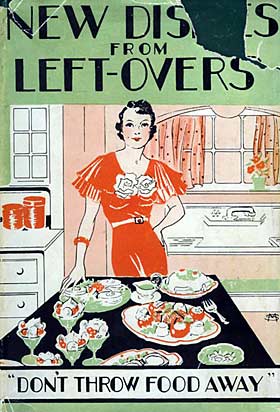
HOW NOW BROWN COW
Sunday July 27th 2008, 1:05 pm
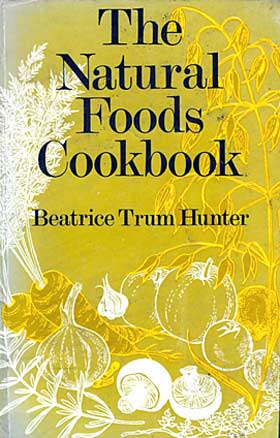
I became a vegetarian in 1972. Since then, at different times, I have explored veganism, followed a macrobiotic diet and been a pescatarian (is there such a word? an annoying vegetarian who happens to eat fish) but have only on one occasion knowingly eaten meat (too long a story!). I was never a great meat eater as a child so never felt I had made a huge sacrifice and it has never been my mission to convert others, I simply made a personal choice and that was that. It has never felt like a big deal but it was outside the mainstream, an approach that has always appealed to me.
In the years since 1972 I can’t tell you how many times I have been turned on at the dinner table by carnivorous strangers demanding I explain my reasons for not eating meat, or the times I have been with meat eaters discussing how every vegetarian they know looks pale, pasty and unhealthy. But I have always risen above it and it hasn’t bothered me. In 1972 it was difficult to eat out anywhere and find anything vegetarian on the menu and in subsequent years it has become much easier. I can remember some woman or other once saying to me ‘it wont kill you’ when I was querying whether a mushroom pizza had bacon on it and me, too shy to say boo to a goose, being embarassed. Most restaurants now offer at least one! meat-free option if not more and the ‘oh, you must eat nut roast then’ assumption has gladly gone. Meat eaters tend to be very concerned about how vegetarians get their protein.
On becoming a vegetarian, the first book I borrowed from the library was The Natural Foods Cookbook by Beatrice Trum Hunter (first published in 1963). This book includes chapters on meat and fish, but I remember feeling like I was reading a book written in a foreign language. So many of the ingredients were unknown to me, strange grains, weird pulses and vegetables that had never been seen in Lancashire where I grew up. But I was hungry for knowledge and lapped it all up, rereading and renewing this book from the library until I started to make sense of it all. Then, only specialist health food shops that were considered outside the loop stocked some of the ingredients. Seeking them out was also part of the challenge. I have just managed to find a copy on ebay and it is really interesting to assess how things have changed now these ingredients can be found in most supermarkets.
A while ago I was listening to a discussion on Radio 4 about animal rights. A young well-spoken woman made the point that humans are qualified to be considered superior beings because no animal has written a great work of literature. As far as I am aware no animal has written even a rubbish book but occasionally a dog manages to say ‘sausages’ as its party piece so perhaps we aren’t far away from a celebrity doggie chef.
More recently I have started to get annoyed. Annoyed enough that my being a vegetarian has started to matter. Whilst the interest in ethically reared and slaughtered meat improves the lives of animals, which is good, it feels like there is a real blokey, gung-hoe attitude attached. ‘Have you got the bottle to do the deed and slaughter your own meat?’ I like Hugh Fearnley-Whittingstall and loved his in-your-face-title for his book ‘Meat’, (it does what it says on the can), but when slaughtering animals becomes classed as TV entertainment it really depresses me. On his programme he featured a long-time vegetarian who wanted to eat meat again so was being taught how to butcher the carcass, WHY A VEGETARIAN? Gordon Ramsay, who regularly makes jibes about vegetarians also recently fed meat to a vegetarian stating that you must eat meat to follow a healthy diet and has on several occasions given animals reared for slaughter witty names of other celebrity chefs. In the TV listing for the next ‘F Word’ programme, ‘Janet Street-Porter serves veal calves to 50 vegetarians keen to eat meat again!’ I am starting to wonder whether we are being fed propaganda by the Meat Marketing Board, or whatever it is called these days. What’s with all these conversions?
The fact of the matter is that we have a multitude of choices in the west of what we eat. We can live perfectly healthily without meat if we want too. So it is really refreshing when you come across a book like ‘Wild Garlic, gooseberries….. and me’ by Denis Cotter. This book gives me faith that for some, things have moved on in an inspiring and intelligent way. Denis writes about his ingredients so beautifully that in comparison, calling a pig Anthony Worral-Thompson seems pure trailer trash. And strangely, seeing my book from the 70’s beside Denis Cotter’s book there is something not dissimilar about the jackets.

GOING GREEN
Wednesday July 16th 2008, 6:27 pm
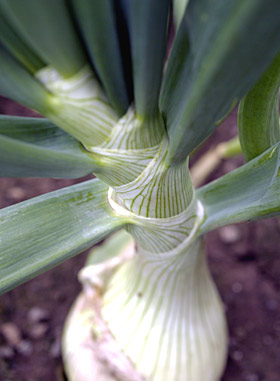
What is so great about gardening is that as a vast ocean of a subject there are always new things to discover and be interested in. You can be passionate about herbaceous borders one minute and then find that your focus has gone elsewhere and suddenly growing potatoes has become all consuming. I do love flowers but right now it is vegetables that really get me going.

I suppose these photographs should be called plant portraits and I like them because they are just shades of green. Plants don’t have to be ‘in your face’, colourful and blousey to be admired and these have the added advantage of being only a short hop from your dinner plate.

THE VILLAGE CARNIVAL
Monday July 14th 2008, 10:15 am

The weekend was an important one in our community calendar, it was time for our annual village carnivaL This gives men an excuse to wear frocks and dogs a reason to wear bandanas and everyone is allowed to let their hair down, especially if it is flourescent green or day-glo orange.
The carnival starts with a procession through the village of decorated floats, the carnival queen and her attendants waft past sat amongst a cloud of fluffy crepe paper flowers and there is a marching band, then it is straight to the playing fields where the carnival gets into full swing. It is always good to make directly for the tea tent where every year the ladies never fail to put on a fabulous spread of homemade cakes and fill cups all day with hot tea.
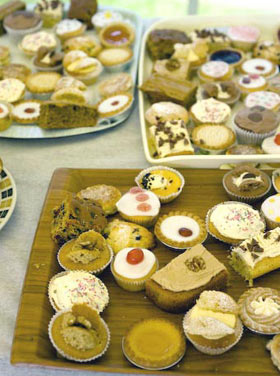
There are displays of school children doing cheerleading routines, tug-of-war teams battle it out to even scores from the year before and a lucky dip to win a jar of pickled onions or a bar of soap. This year a chocolate fondue stall made an appearance with skewered strawberries ready for dipping as well as marshmallow kebabs.

A good day was had by all. Now it is looking forward to the next big event, the local produce show in a months time. Last year I entered 2 courgettes in the show, my first time ever taking part. Of course I didn’t win anything but this year… it is going to be serious.

THE ULTIMATE SUMMER HIGH TEA
Wednesday July 09th 2008, 10:08 pm
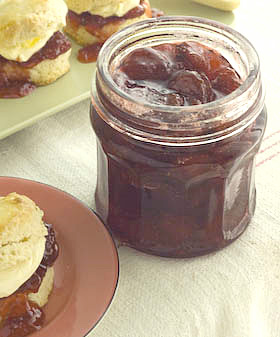
I am currently writing a book on jam making so am busy with a preserving pan. It seems very strange indeed that the end results from combining just two ingredients, fruit and sugar, can vary so much.
A couple of years ago I made some apricot jam and gave a jar to my friend Joy, knowing that she had a particular liking for this preserve and its association, in our minds, with France. She was quite polite but did tell me she had found the jam rather overly sweet. We don’t so often find fresh homegrown apricots on sale in the UK and though I can’t recall the exact details, I had most likely bought imported fruit in the supermarket and was swayed by how nice the amber fruits looked with just a hint of a pink blush that took my thoughts straight to magical times spent in Provence. Back to reality, we all know that out of season imported fruit is usually all blouse and no knickers, rarely matching its promise, and this instance was no exception.
For the book, my criteria required for a recipe to be included is that preserves must capture the real character of the fruit and a sweet nondescript could-be-any-old-fruit taste is certainly not worth the effort involved. As nowadays too much sugar is a bit off putting as well, reducing the sugar content where possible is an added bonus, though the sugar is an essential part of what helps the jam to keep, which means there is a limit to how little you can use. So when I made the best strawberry and vanilla jam I have ever tasted, using locally grown fruit full of the unmistakable flavour of utmost strawberry and which included less sugar than usual, I thought it worth mentioning. As well as that, strawberry jam teams up perfectly with scones and clotted cream for the classic summer treat. What follows is how to make the ultimate scones, jam and cream from scratch for afternoon tea. If you are making this all in one go, you will need to begin two days before as the fruit, vanilla and sugar needs to marinade, or should I say macerate, overnight before you make it into jam and once made it has to be left till cold. The jam has quite a soft set, which again is very lovely and guaranteed to ooze out of the scones.
My Mum always makes scones with dried fruit in them and the habits you grow up with are hard to break away from, but here a plain scone is definitely what is required. Make the scones quite small as well, no bigger than 5cm diameter, just eat twice as many.
Let’s start with the jam…..
BIRDSONG IN QUEBEC
Tuesday July 01st 2008, 1:08 am
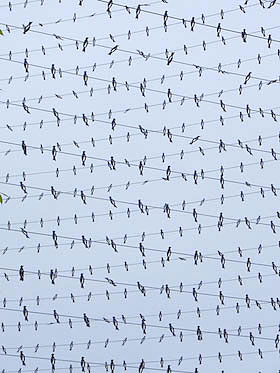
NIPpaysage are four landscape architects in Montréal whose striking projects currently include a garden, commissioned by Hydro-Quebec electricity company, which is part of the International Garden Festival at les Jardins de Métis, Reford Gardens in Quebec. The garden is bounded by fences made of parallel strung electricity wires on which perch thousands of birds to illustrate the many uses of hydro wires in the landscape. The Laundry supplied the 5400 bird pegs required for the installation. Thank you to Mathieu Casavant at NIPpaysage for sending me this photograph.
Find out more about the festival here.
The International Garden Festival is on until October 5th.


